This year we decided to highlight the International Women’s Strike set for March 8th, 2017 whose aims completely fit into the framework that we have set for understanding and recovering the history of International Women’s Day. We hope that women will participate in these strikes in whatever way that they can do.
Drawing inspiration from struggles in Poland where women went out on strike to oppose a law that would have illegalised abortion, struggles in Ireland and South Korea to defend women’s reproductive rights, and struggles throughout Latin America fighting violence against women, the strikes’ organisers hope to shift the focus of the nascent women’s movement towards a feminism for the 99%. Arguing that Corporate Feminism has failed the vast majority of women, they are struggling to pull together a feminism that combines economic, political and social issues that impact the vast majority whose lives are affected by the combined impact and interplay of race, class, and gender. In discussing these various inspirations, they stated:
“What is striking about these mobilizations is that several of them combined struggles against male violence with opposition to the casualization of labor and wage inequality, while also opposing homophobia, transphobia and xenophobic immigration policies. Together, they herald a new international feminist movement with an expanded agenda: at once anti-racist, anti-imperialist, anti-heterosexist and anti-neoliberal (www.theguardian.com/...).“
According to two of the organisers, Cinzia Arruzza and Tithi Bhattacharya:
“Feminist, grassroots, and socialist organizations around the world have called for an International Women’s Strike on March 8 in defense of reproductive rights and against violence, understood as economic, institutional, and interpersonal violence.
The strike will take place in at least forty countries — the first internationally coordinated day of protest on such a large scale in years: in terms of size and diversity of organizations and countries involved, it will be comparable to the international demonstrations against the imperialist attack on Iraq in 2003 and to the international protests coordinated under the banner of the World Social Forum and the global justice movement in the early 2000s.
While Occupy, the indignados, and Black Lives Matter did manage to have international echo and to trigger demonstrations, occupations, and protests in a number of country, there was little conscious international coordination among the various organizations and groups involved. The Arab revolutions were an extraordinary and historic event, but social and political organizations in other countries failed to give birth to a powerful internationally coordinated mobilization in their support.
If it succeeds, the International Women’s Strike will mark a qualitative and quantitative leap in the long process of reconstructing an international social mobilization against neoliberalism and imperialism, to which the various movements of recent years, from Occupy to Gezi Park, from the indignados to Standing Rock and Black Lives Matter have given form. It will also signal the concrete possibility for a new, powerful, anticapitalist, and internationalist feminist movement (www.internationalviewpoint.org/...).”
Tonight's piece is a co-production of NY Brit Expat and Geminijen. What we decided we wanted to do was to allow women to speak for themselves, so we reproduced some quotes from these women. We wanted to discuss not only women that were known as leaders or that were heralded during their times; we also want to remind people of the voices of those who fought on the shop-floors, those that became “leaders” due to circumstance. Their actions and speeches inspired and moved others and they are still relevant. However, since its inception in the early 1900s, it has inspired many other actions and women around the world from Africa to China to Latin America and Europe. In the United States it was repressed for much of the 20th century, except in small radical communities, due to the strong anti-socialist bias. It was revived under the second wave of feminism in the 1970s and continues among progressives today.
International Women's Day (8 March) was originally called International Working Women’s Day. It was a socialist holiday established in 1911 by the Socialist International and is celebrated by women's groups around the world. In many countries, it is a national holiday and has recently been officially recognized by the United Nations. However, up until the 1970's, with the advent of a new women's movement, the radical working class roots of IWD had been practically forgotten. Due to its socialist leaning, it was excised from the United States memory, much as Labor Day replaced May Day, except in small immigrant enclaves or radical union groups. In Europe and the rest of the world, it continued to be widely celebrated, but tended to honour women in name only, mostly with flowers or by simply putting a woman's face on a male agenda. IWD, in fact, was the culmination of a century of women working in the labour, feminist, socialist, and anti-slavery and segregation movements to bring together the common interests of the working class and women's rights advocates.
Three major trends led to the establishment of IWD. The first was a revolutionary fervour in Europe and the United States toward socialism, democratization and the vote. In Europe it was exemplified by a movement for working class men without property seeking the vote to further a socialist government, paralleled by a movement for middle class women to get the vote. This situation was mirrored in the United States by the struggle to gain the vote for black men and white women. The contradictions between these two types of suffrage movements were evident (should we fight for the non-propertied or black men to get the vote, even if women were excluded?). The solution, of course, was to get the vote for both groups.
Clara Zetkin was among the early socialists to see working class women as the driving force towards universal suffrage (everyone gets the vote independent of property qualifications to which it had been historically tied) since they bridged the divide, yet retain the principle of a revolutionary socialist agenda. It was Clara Zetkin who advocated for the merging of the working class socialist movement and the women's movement through the establishment of International Women's Day as a way to forward the goals of both labour and women. The first clear victory in which the leadership of working class women following the establishment of IWD were the organization of the textile workers and women's suffrage in the United States and the second victory was Russian Revolution in 1917 which began with a massive strike by women textile workers in Petrograde (St. Petersburg) on International Women's Day. This strike was called against the orders of the Unions and left-wing political parties. The strikes lit the match of a country on the verge; they doubled in size to 200,000 workers and over the next few days, 66,000 men of the local army garrison joined forces with the strikers. The February Russian revolution began and the Tsar was forced to abdicate.
The third important factor was the increased numbers of women in the labour movement, particularly in the textile industry, as more and more women were pulled into factories and out of homes with the rise of industrial capitalism. Their struggle to free themselves from the patriarchal home and obtain decent work conditions in the marketplace instead of being viewed as cheap labour is exemplified in the call for both "bread and roses." The textile strikes beginning in 1857 and the massive strikes between 1908 and 1915 were the activist expression of women's struggle for power. This was especially true after the horror of the Triangle Shirtwaist factory strike where mostly women workers, but also children and a few men were killed in a horrific sweatshop fire soon after a strike of textile workers (The Uprising of the 20,000) in New York city demanding trade union recognition, better wages, working conditions and health and safety measures.
While initially the feminist movement focused on human rights issues for women such as suffrage, many of the women felt allied to working class struggles for decent wages and rights and took up the call that freedom and equality for one group meant freedom and equality for all. While the anti-slavery movement seems distinct, the end of slavery pushed all workers, black and white into the same labour struggle as wage labourers. Once this occurred, it was up to anti-racist groups to fight for equality within the labour movement. This, of course, always raised the question of equality for the other major group excluded from equality in the labour force -- women. These movements, occurring in a short period between the end of the civil war and the end of WW1, provided the activist and theoretical base to try to unite diverse groups into the revolutionary struggle. The formation of IWD was an explicit effort to unite the interests and theories of women and male labour (including workers of colour that was implied in the socialist agenda) under a Revolutionary Socialist agenda in support of universal suffrage and economic equality. The following excerpts (which we hope you will read, view, sing-along- with, explore and enjoy) are just a sampling of some of the actions and words of some prominent working women and movements.
We need to go back to the rise of the post-Civil War labour movement and the first wave of feminism to see the inevitable class contradictions that arose between women of the bourgeoisie and women of the working class. The differences in approach are obvious when we look at the issues. Bourgeois women advocating women’s suffrage linked it to property qualifications and argued that women as a group should be enfranchised without looking at how this left blacks and many non-propertied workers without the vote. The birth control movement also wound up linking to eugenics groups that were aligned to repugnant issues targeting the poor and people of colour. To win equality for all people, women of the left argued that the economic and social exploitation endemic to the capitalist system be eliminated by the triumph of socialism. While suffrage and access to birth control were clearly important reform issues, they would not in and of itself enable all women’s, or for that matter, all people's equality. . However when reformist men chose to limit their call for the vote to blacks and non-propertied working men --forgetting that this still excluded women--the dynamics shifted and the call for socialists to specifically include women in their demand for the vote was born.
“Sojourner Truth" (1797-1883):
“Well, children, where there is so much racket there must be something out of kilter. I think that 'twixt the negroes of the South and the women at the North, all talking about rights, the white men will be in a fix pretty soon. But what's all this here talking about? That man over there says that women need to be helped into carriages, and lifted over ditches, and to have the best place everywhere. Nobody ever helps me into carriages, or over mud-puddles, or gives me any best place! And ain't I a woman? Look at me! Look at my arm! I have ploughed and planted, and gathered into barns, and no man could head me! And ain't I a woman? I could work as much and eat as much as a man - when I could get it - and bear the lash as well! And ain't I a woman? I have borne thirteen children, and seen most all sold off to slavery, and when I cried out with my mother's grief, none but Jesus heard me! And ain't I a woman? Then they talk about this thing in the head; what's this they call it? [member of audience whispers, "intellect"] That's it, honey. What's that got to do with women's rights or negroes' rights? If my cup won't hold but a pint, and yours holds a quart, wouldn't you be mean not to let me have my little half measure full? Then that little man in black there, he says women can't have as much rights as men, 'cause Christ wasn't a woman! Where did your Christ come from? Where did your Christ come from? From God and a woman! Man had nothing to do with Him. If the first woman God ever made was strong enough to turn the world upside down all alone, these women together ought to be able to turn it back, and get it right side up again! And now they is asking to do it, the men better let them. Obliged to you for hearing me, and now old Sojourner ain't got nothing more to say (www.fordham.edu/...).”
There has been some debate as to whether or not Sojourner Truth actually said the words "Ain't I a woman" as the speech was reconstructed. For balance we are including the original 1851 report by Marcus Robinson, although the words "ain't I am woman" are not there, the content of the speech clearly says this without using the words. Alice Walker prefers the original speech above and we are keeping it. Essentially, the controversy is over a resource written by a guy in a newspaper that was one month after the event vs. an informal report by a woman who was at the event. Which resource is more legitimate? Since sources from the side of the oppressed are always both "stronger" - less polite - and de-legitimatized, we am opting for the female on the spot source vs. the male resource with (as the article shows) a specific agenda in terms of tone.
Harriot Stanton Blatch recalled how as a 10-year-old, she once read the morning papers to visiting SOJOURNA TRUTH as she smoked her pipe. Young Blatch asked,"Sojourner, can't you read?" To which Truth answered, "
Oh no, honey, I can't read little things like letters. I read big things like men."
Born a slave named Isabella, Sojourna bore at least 5 children, 2 girls sold from her, won her son back form Alabama slaveholder, worked as a cook, maid and laundress in New York City, illiterate, preached against prostitution 1830, a mystic, chose name 1843, preached throughout Long Island and Connecticut, at abolitionist meetings, spoke at women's rights meetings in 1850s, and is remembered for her dramatic "Ain't I a Woman?" speech delivered at the Women's convention in Akron, Ohio in 1851.
Labour and Organising: Early 20th century US labour history and its relation to international women’s day:
MARY HARRIS “MOTHER” JONES (1837-1930)
"A lady is the last thing on earth I want to be. Capitalists side-track the women into clubs and make ladies of them.” “No matter what the fight, don’t be ladylike! God almighty made women and the Rockefeller gang of thieves made the ladies.”
Labor organizer Mother Jones worked tirelessly for economic justice. While her opponents called her the “most dangerous woman in America,” fellow organizer Elizabeth Gurley Flynn called Jones “the greatest woman agitator of our times.” Jones combined dynamic speaking skills and radical organizing methods to mobilize thousands of laborers and working-class families. She said of herself,
“I’m not a humanitarian; I’m a hell-raiser.”
Mother Jones' organizing methods were unique for her time. She welcomed African American workers and involved women and children in strikes. She organized miners’ wives into teams armed with mops and brooms to guard the mines against scabs. She staged parades with children carrying signs that read, "We Want to Go to School and Not to the Mines."
Here is a short video on the life of Mother Jones:
Mary Harris "Mother" Jones was born in Cork, Ireland, moved to the United States in the 1840s, where her father worked in railroad construction. Mary became a teacher after trying her hand at dressmaking. In 1861 married a member of Iron Molders’ Union in Memphis. Six years later, she lost her husband and four young children to a yellow fever epidemic, and returned to Chicago to open a seamstress shop. After losing all her possessions in the great Chicago fire of 1871, Jones sought community in the Knights of Labor. She reconstructed herself as “Mother” Jones, radical organizer. Five-feet tall with snow-white hair, all black dress and confrontational style, Jones was indeed a fierce maternal presence.
From the late 1870s through the early 1920s, Jones participated in hundreds of strikes across the country. Living by the philosophy, “wherever there is a fight,” she supported workers in the railroad, steel, copper, brewing, textile, and mining industries. In 1903 she organized children textile workers to march on President Theodore Roosevelt’s home. Mary, like many working class women, saw the suffrage movement as an upper class women’s distraction, saying,
“the plutocrats have organized their women. They keep them busy with suffrage and prohibition and charity.”
Although she was suspicious of feminists, her courage and organizing were part of the struggle that informed International Women's Day and deserves to be remembered on this day if for no other reason that the preceding cautionary quotes.
Lucy Parsons (born c. 1853 – March 7, 1942)
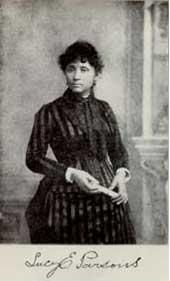
“We, the women of this country, have no ballot even if we wished to use it, and the only way that we can be represented is to take a man to represent us. You men have made such a mess of it in representing us that we have not much confidence in asking you [...] We [women] are the slaves of slaves. We are exploited more ruthlessly than men. Whenever wages are to be reduced the capitalist class use women to reduce them, and if there is anything that you men should do in the future it is to organize the women [...] Now, what do we mean when we say revolutionary Socialist? We mean that the land shall belong to the landless, the tools to the toiler, and the products to the producers. [. . .] I believe that if every man and every woman who works, or who toils in the mines, mills, the workshops, the fields, the factories and the farms of our broad America should decide in their minds that they shall have that which of right belongs to them, and that no idler shall live upon their toil . . . then there is no army that is large enough to overcome you, for you yourselves constitute the army . . . . My conception of the strike of the future is not to strike and go out and starve, but to strike and remain in and take possession of the necessary property of production […].” (Lucy Parsons, 1905).
Lucy Parsons was a founding member of the IWW (International Workers of the World). She worked as an organizer for the IWW and anarchist activist who was a major organizer of the Haymarket Affair of 1886 in Chicago that led to the massacre of eight workers (her husband was executed in 1887 on charges of conspiring with the Haymarket Riot), addressed the founding convention of the IWW on two occasions. She was described by Chicago Police Department in the 1920s as “more dangerous than a thousand rioters .” Her speeches touched on issues close to her heart: the oppression of women and how to develop radical new tactics to win strikes. Her ideas clearly were in advance of the time, presage the "sit-in" strikes of the 1930s, the anti-war movement of the 1960s, and her words resonate today. Delegate applause interrupted her speech several times and at the end.
The Uprising of the 20,000
Interestingly enough while people may have heard the name of the Triangle Shirtwaist factory, it is often mostly known due to the horrific fire in 1911. However, the Triangle Shirtwaist factory plays quite a role in the history of trade union struggles in NYC; it was in response to the horrific working conditions at the factory that workers staged a short-term strike which resulted in a lock-out by the company. This led to a 14 week strike known as the "Uprising of the 20,000."
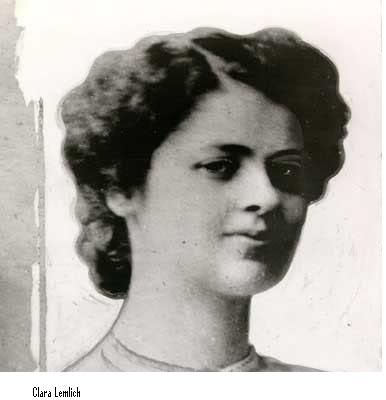
"The news of the strike spread quickly to all the New York garment workers. At a series of mass meetings, after the leading figures of the American labor movement spoke in general terms about the need for solidarity and preparedness, Clara Lemlich rose to speak about the conditions she and other women worked under and demanded an end to talk and the calling of a strike of the entire industry. The crowd responded enthusiastically and, after taking a traditional Yiddish oath, "If I turn traitor to the cause I now pledge, may this hand wither from the arm I now raise," voted for a general strike. Approximately 20,000 out of the 32,000 workers in the shirtwaist trade walked out in the next two days."
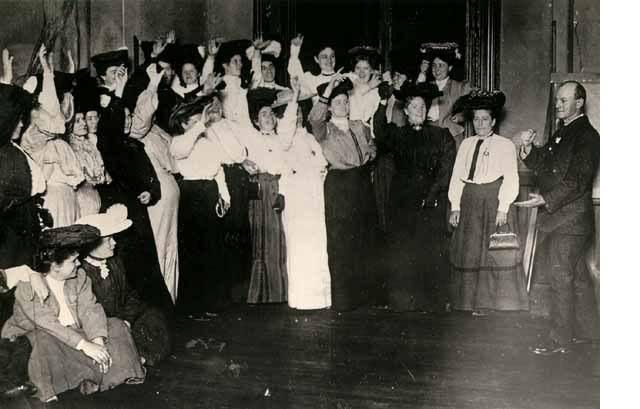
The Uprising of the Twenty Thousand Dedicated to the Waistmakers of 1909 In the black of the winter of nineteen nine, When we froze and bled on the picket line, We showed the world that women could fight And we rose and won with women's might. Chorus: Hail the waistmakers of nineteen nine, Making their stand on the picket line, Breaking the power of those who reign, Pointing the way, smashing the chain. And we gave new courage to the men Who carried on in nineteen ten And shoulder to shoulder we'll win through, Led by the I.L.G.W.U. (From: Let's Sing! Educational Department, International Ladies' Garment Workers' Union, New York City, n.d.)."
The strike was not completely successful. While Union recognition was not achieved, conditions on working hours, health and safety standards and wages were agreed but many employers in the industry (including the Triangle Shirtwaist Factory owners) refused to sign. In 1910, the ILGWU led a strike of 60,000 cloakmakers called "The Great Revolt" that lasted several months and which led to higher wages, union recognition rudimentary health benefits, and an agreement of arbitration rather than strikes to settle disagreements between workers and employers.
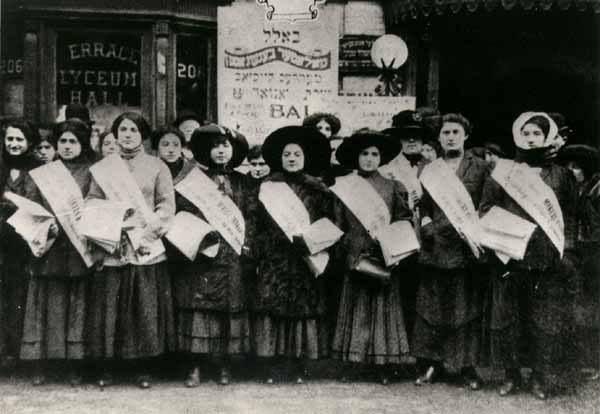
Hannah Shapiro Glick
“It wasn't because I wanted to work, but I could see that every little cent helped. ...I went to work at Hart, Schaffner & Marx; I thought, "I have to better myself." [...] There's nothing like in a big place to work; 'cause they have a wonderful system to work. [...] We got along nicely with every language, let me tell you, but I always minded my own business, but when it came to this, [the strike] I couldn't stand this [...]. They were all afraid to say a word but I wasn't [...]. People who are older than I am would stay in the house and not to budge. So I was the first one [...] If not for me, it seems they couldn't move [...] I'm a strong girl; I never regretted it [...] I think if not for the strike, they would never have what they have now; we had to strike and I think we had the right to go [...]. They stayed like glue; they felt they had to show we have to be recognized as people and, really, we struggled; it wasn't easy [...]The workingman has to live too, that's what it had to show and it did too (Identifying A Lost Leader).” (excerpted from research by Rebecca Sive).
In 1922, Hannah Shapiro was identified in the Amalgamated Clothing Workers Joint Board Report as the initiator of the 1910 Chicago strike. Although she never emerged as a political leader, Glick was one of the "girl strikers" Buhle's Socialist thinkers admired. On September 22, 1910, Hannah [a.k.a. "Annie"] Shapiro (later Glick), a seventeen-year-old Jewish immigrant born in the Ukraine, initiated the workers' walkout in shop 5 of a major clothing manufacturer. Shapiro, complained to her foreman about a cut in the piecework rate from 4 cents to 3 & 3/4 cents for seaming a pair of pants. He replied that nothing could be done. Under Shapiro's leadership, workers from shop 5 walked out. By Wednesday, workers in other company shops refused to do the work of Shapiro's shop and, by the end of the week, workers in seven out of ten Hart, Schaffner & Marx shops were out. A month later, 40,000 Chicago garment workers were on strike. By her own account, Glick was young, fearless, and responsive to the righteousness of the workers' struggle. Her convictions gave her strength; she was a tireless picketer and a good speaker, though not a trained organizer. Although she remembered meeting Jane Addams, dancing with Clarence Darrow [who represented the workers during arbitration], organizing with Agnes Nestor and Mary Dreier Robins, and watching Bessie Abramovitch (Hillman) flirt, She had no memory of Clara Masilotti, the Italian strike leader. Furthermore, Glick does not appear "conferring" in any photographs, nor did she write any articles about the strike, or teach English to strikers She did not speak at meetings of the workers, as Abramovitch did. However, she was always her own woman. She did not participate in the selling of the "Special Girl Strikers' Edition" of the Chicago Daily Socialist because she did not agree with Socialist organizing tactics. Of her own significance in the strike, Glick said
"The strike, I'll tell you the truth for me, it was a joke, but for the married people...But I was the spokes [sic]... At first they said, 'A young girl, what does she know, good from bad, couldn't she make up 1/4 cent? ... Women can't stick to anything.'
In retrospect, she saw her importance as having been a model of steadfast courage.
The Creation of International Women's Day
The declaration of a women's day was called by the Socialist Party of the US in 1909 and was celebrated across the US on February 28th. In fact, it was celebrated in the US on the last Sunday in February up until 1913. In 1910, at the Socialist (second) International in Copenhagen, Clara Zetkin suggested the creation of International Women's day was established to honour women's rights and to support the struggle for women's suffrage. In 1911, the first international women's day was celebrated on March 19th by demonstrations in Austria (1918), Germany (1918), Denmark (1915) and Switzerland (1971) where over 1 million women and men attended the demonstrations. The dates in parentheses indicate when women achieved not only the right to vote, but the right to vote independently of property qualifications. This most basic right of bourgeois democracies was denied to women and is still denied in many countries.
Some More US Labour History: The Triangle Shirtwaist Factory Fire
And this leads us once again to the Triangle Shirtwaist Factory and the fire on March 25th 1911. The death of 146 people (129 women mostly young immigrants and 17 men; 146 out of 500 people employed at the company) either burnt to death or who died after jumping from the building.
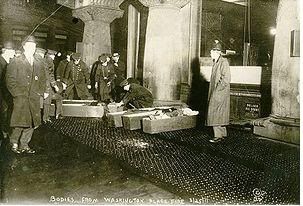
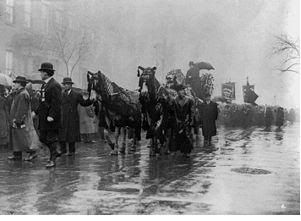
At the memorial meeting, Rose Schneiderman gave a speech that has meaning even today.
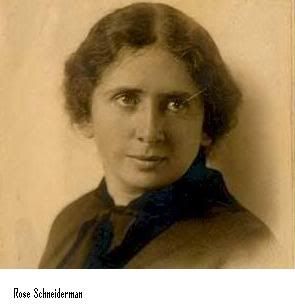
The Bread and Roses Strike (Lawrence MA, 1912)
Elizabeth Gurley Flynn, along with Joseph Ettor was one of the major organisers for the 1912 Lawrence Textile Strike, aka the “Bread and Roses Strike” derived from a sign carried by a woman worker. Lawrence MA was a mill town; housing was “provided” for workers and was priced higher than elsewhere in New England. Other workers lived in cramped tenements. According to Jone Johnson Lewis, the average worker at Lawrence earned less than $9 per week; housing costs were $1 to $6 per week. Introduction of new machinery lead to a speed-up leading to increased productivity but lower wages and less hours available to work. The strike began on January 11th when a few Polish women workers went on strike as their pay was shorted. The next day, 10,000 workers went out; strike numbers rose to 25,000.
The IWW was the main organising force, after meeting with them, the workers demanded: • 15% pay increase • 54 hour work week • overtime pay at double the normal rate of pay • elimination of bonus pay, which rewarded only a few and encouraged all to work longer hours
Needless to say, the city responded rather badly to the strike.
“The city reacted with nightime militia patrols, turning fire hoses on strikers, and sending some of the strikers to jail. Groups elsewhere, often Socialists, organized strike relief, including soup kitchens, medical care, and funds paid to the striking families.
The death of a woman striker, Anna LoPizzo whom was killed as police broke up a picket line on January 29 increased tensions.
“Strikers accused the police of the shooting. Police arrested IWW organizer Joseph Ettor and Italian socialist, newpaper editor, and poet Arturo Giovannitti who were at a meeting three miles away at the time and charged them as accessories to murder in her death. After this arrest, martial law was enforced and all public meetings were declared illegal.”
Dynamite was planted around the town by people paid by the company owners to try and win public sympathy at the expense of the strikers and IWW. Children of the strikers were evacuated to NYC on trains where temporary foster care was provided for them (as an aside, Margaret Sanger was one of the nurses on the train). When the next attempt to relocate children happened; the city reacted violently, mothers and children were clubbed and beaten and children were taken from their parents. This led to a congressional investigation in which the workers actually testified; Helen Taft (the wife of President Taft) actually attended the congressional meetings in sympathy with the workers. This enabled the building of public sympathy as the IWW brought attention to the situation and held solidarity rallies in NY (led by Flynn) and Boston. The company gave in on March 12th to the original demands of the strikers and Ettor and Giovannitti were acquitted of murder on November 26th.
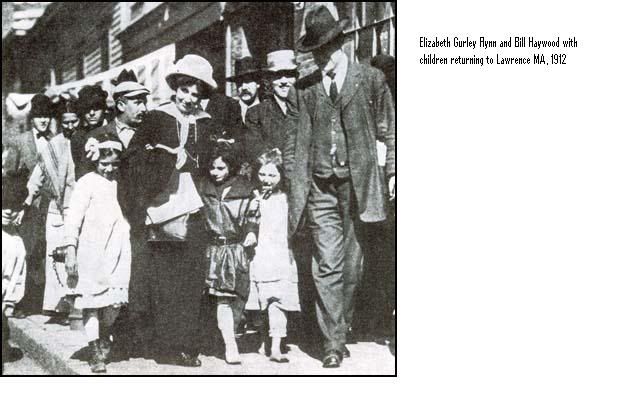
>
Born in Concord, NH to a family of socialists and feminists that finally settled in the Bronx in 1900, Flynn attended public school in the Bronx in New York City. At the age of 16 she gave her first public address to the Harlem Socialist Club, where she spoke on "What Socialism Will Do for Women." Upon her arrest for blocking traffic during one of her soapbox speeches she was expelled from high school, and in 1907 she began full-time organizing for the Industrial Workers of the World (IWW).
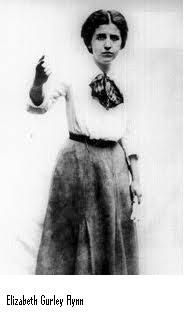
Flynn published two books about her life: The Rebel Girl, An Autobiography: My First Life (1906-1926; revised edition, 1973) and The Alderson Story: My Life as a Political Prisoner (1955). The following books provide discussions of Flynn in the context of women activists and labor radicals: Melvyn Dubofsky, We Shall Be All: A History of the Industrial Workers of the World (1969); Meredith Tax, The Rising of the Women: Feminist Solidarity and Class Conflict, 1880-1917 (1980).
Women’s Suffrage, Race and Class Struggle
The Women’s Suffrage movement split upon both race and class early in its history.
CLARA ZETKIN. (1857-1933)
“As far as the proletarian woman is concerned, it is capitalism’s need to exploit and to search incessantly for a cheap labor force that has created the women’s question. It is for this reason, too, that the proletarian woman has become enmeshed in the mechanism of the economic life of our period and has been driven into the workshop and to the machines. She went out into the economic life in order to aid her husband in making a living, but the capitalist mode of production transformed her into on unfair competitor. She wanted to bring prosperity to her family, but instead misery descended upon it. The proletarian woman obtained her own employment because she wanted to create a more sunny and pleasant life for her children, but instead she became almost entirely separated from them. She became an equal of the man as a worker; the machine rendered muscular force superfluous and everywhere women’s work showed the same results in production as men’s work. And since women constitute a cheap labor force and above all a submissive one that only in the rarest of cases dares to kick against the thorns of capitalist exploitation, the capitalists multiply the possibilities of women’s work in industry. As a result of all this, the proletarian woman has achieved her independence. But verily, the price was very high and for the moment they have gained very little. If during the Age of the Family, a man had the right (just think of the law of Electoral Bavaria!) to tame his wife occasionally with a whip, capitalism is now taming her with scorpions. In former times, the rule of a man over his wife was ameliorated by their personal relationship. Between an employer and his worker, however, exists only a cash nexus. The proletarian woman has gained her economic independence, but neither as a human being nor as a woman or wife has she had the possibility to develop her individuality. For her task as a wife and a mother, there remain only the breadcrumbs which the capitalist production drops from the table. Therefore the liberation struggle of the proletarian woman cannot be similar to the struggle that the bourgeois woman wages against the male of her class. On the contrary, it must be a joint struggle with the male of her class against the entire class of capitalists. She does not need to fight against the men of her class in order to tear down the barriers which have been raised against her participation in the free competition of the market place. Capitalism’s need to exploit and the development of the modern mode of production totally relieves her of having to fight such a struggle. On the contrary, new barriers need to be erected against the exploitation of the proletarian woman. Her rights as wife and mother need to be restored and permanently secured. Her final aim is not the free competition with the man, but the achievement of the political rule of the proletariat. The proletarian woman fights hand in hand with the man of her class against capitalist society. To be sure, she also agrees with the demands of the bourgeois women’s movement, but she regards the fulfillment of these demands simply as a means to enable that movement to enter the battle, equipped with the same weapons, alongside the proletariat (Zetkin).”
Radical Socialist and feminist, Clara Zetkin joined the Social Democratic Workers' Party of Germany in 1875. Zetkin belonged to the Radical wing of the Party along with Rosa Luxemburg. She married a Russian revolutionary living in exile (Clara Zetkin bibliography).
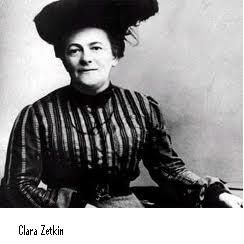
"What made women's labour particularly attractive to the capitalists was not only its lower price but also the greater submissiveness of women. The capitalists speculate on the two following factors: the female worker must be paid as poorly as possible and the competition of female labour must be employed to lower the wages of male workers as much as possible. In the same manner the capitalists use child labour to depress women's wages and the work of machines to depress all human labour."
In 1891 Zetkin became editor of the SPD's journal, Die Gleichheit (Equality). An impressive journalist, Zetkin took the circulation from 11,000 in 1903 to 67,000 three years later. She was also active against militarism. At the time of WWI, Zetkin wrote in November, 1914:
"When the men kill, it is up to us women to fight for the preservation of life. When the men are silent, it is our duty to raise our voices in behalf of our ideals."
A strong campaigner for women's suffrage, Zetkin was elected secretary of the International Socialist Women. In 1907, she became the leader of the women’s office at the SPD (German Social Democratic Party) and organized the first international women’s conference (Clara Zetkin). She wrote:
"The socialist parties of all countries are duty bound to fight energetically for the implementation of universal women's suffrage which is to be vigorously advocated both by agitation and by parliamentary means. When a battle for suffrage is conducted, it should only be conducted according to socialist principles, and therefore with the demand of universal suffrage for all men and women [irrespective of class and property ownership].”
In 1910 at the Second International, she advocated for the formation of International Women's Day on March 8th).
Video of Zetkin:
IDA BELL WELLS-BARNETT (Holy Springs, Mississippi) July 16, 1862 - March 25, 1931)

On March 3, 1913, as 5,000 women prepared to parade through President Woodrow Wilson's inauguration, demanding the right to vote, Ida B. Wells was standing to the side. A black journalist and civil-rights activist, she had taken time out from her anti-lynching campaign to lobby for woman suffrage in Chicago. But a few days earlier, leaders of the National American Woman Suffrage Association (NAWSA) had insisted she not march with the Illinois delegation. Certain Southern women, they said, had threatened to pull out if a black woman marched alongside whites. A constitutional amendment for woman suffrage, the object of the parade, would have to be ratified by two-thirds of the state legislatures after garnering two-thirds votes in both the House and Senate. In the Southern states, opposition to woman suffrage was intensified as legislators feared that granting women the vote would add even more black voters to the voting rolls. So, the parade organizers reasoned, a compromise had to be struck: African American women could march in the suffrage parade, but in order to prevent raising even more opposition in the South, they would have to march at the back of the march. The organizers of the march asked that the African American women march at the back of the parade. Mary Terrell accepted the decision. But Ida Wells-Barnett did not. She tried to get the white Illinois delegation to support her opposition of this segregation, but found few supporters. The Alpha Suffrage Club women either marched in the back, or, as did Ida Wells-Barnett herself, decided not to march in the parade at all. But, as the parade progressed, Wells-Barnett emerged from the crowd and joined the (white) Illinois delegation, marching between two white supporters. She refused to comply with the segregation. This was neither the first nor the last time that African American women found their support of women's rights received with less than enthusiasm. Didn't black women have as much right to vote as white women? Sixty-five years earlier, at the dawn of the woman's suffrage movement, most suffragists would have said yes. In fact, early feminists were often anti-slavery activists before they started arguing for women's rights. And the parallels between black slaves — who could not vote or hold property — and women — who could do neither in most states — couldn't be ignored (Sources: Civil Rights Activist and Women Marchers).
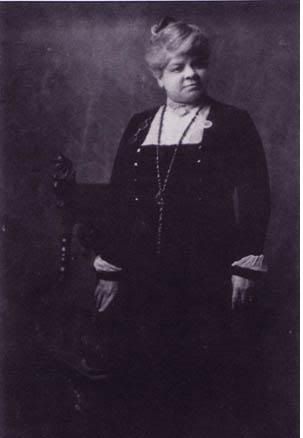
Emma Goldman (June 27 [O.S. June 15] 1869 – May 14, 1940)
“The history of progress is written in the blood of men and women who have dared to espouse an unpopular cause, as, for instance, the black man's right to his body, or woman's right to her soul.” “Needless to say, I am not opposed to woman suffrage on the conventional ground that she is not equal to it. I see neither physical, psychological, nor mental reasons why woman should not have the equal right to vote with man. But that can not possibly blind me to the absurd notion that woman will accomplish that wherein man has failed. If she would not make things worse, she certainly could not make them better. To assume, therefore, that she would succeed in purifying something which is not susceptible of purification, is to credit her with supernatural powers. Since woman's greatest misfortune has been that she was looked upon as either angel or devil, her true salvation lies in being placed on earth; namely, in being considered human, and therefore subject to all human follies and mistakes. Are we, then, to believe that two errors will make a right? Are we to assume that the poison already inherent in politics will be decreased, if women were to enter the political arena? The most ardent suffragists would hardly maintain such a folly. As a matter of fact, the most advanced students of universal suffrage have come to realize that all existing systems of political power are absurd, and are completely inadequate to meet the pressing issues of life (Women's Suffrage).”
Emma Goldman
Born in Kovno in the Russian Empire to an orthodox Jewish family, Goldman emigrated to the US in 1885 and moved first to Rochester, NY before she moved and settled to live in NYC. An anarchist writer, theoretician and activist, Goldman wrote and worked extensively on women’s issues on birth control, marriage (she was an ardent supporter of “free love”), and freedom of speech, an opponent of homophobia, militarism and conscription. A believer in direct action and violence to support political ends, she was imprisoned several times for “incitement to riot.” In 1892 she was involved in the Homestead strike by the Amalgamated Association of Iron and Steel Workers (against the Homestead PA steel plant owned by Andrew Carnegie and run by Henry Clay Frick a strong opponent of the union). Her lover, Alexander Birkman, tried unsuccessfully to kill Frick in an attempt to strike terror and raise political consciousness (he was sentenced to 22 years in prison for the attempt). In 1901, Leon Czolgosz shot President McKinley (who died from his wounds). Czolgosz said that he was inspired after listening to one of Goldman’s speeches but said that she had no role in the assassination. He was executed for the crime, but she refused to condemn his actions and was vilified leading to a crackdown on anarchists under Teddy Roosevelt the succeeding president. Goldman founded the journal “Mother Earth” in 1906 and when Beckman was released he took over control of the journal while she toured the country advocating anarchism, birth control, free-love and freedom of speech for the next 10 years. Their relationship broke down and Goldman formed a relationship with Ben Reitman (her "hobo" doctor).
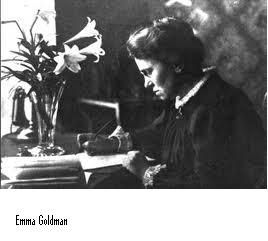
Rosa Luxemburg (1871-1919) From Women’s Suffrage and Class Struggle (1912)
“Economically and socially, the women of the exploiting classes do not make up an independent stratum of the population. They perform a social function merely as instruments of natural reproduction for the ruling classes. The women of the proletariat, on the contrary, are independent economically; they are engaged in productive work for society just as the men are. Not in the sense that they help the men by their housework, scraping out a daily living and raising children for meagre compensation. This work is not productive within the meaning of the present economic system of capitalism, even though it entails an immense expenditure of energy and self-sacrifice in a thousand little tasks. This is only the private concern of the proletarians, their blessing and felicity, and precisely for this reason nothing but empty air as far as modem society is concerned. Only that work is productive which produces surplus value and yields capitalist profit – as long as the rule of capital and the wage system still exists. From this standpoint the dancer in a cafe, who makes a profit for her employer with her legs, is a productive working-woman, while all the toil of the woman and mothers of the proletariat within the four walls of the home is considered unproductive work. This sounds crude and crazy but it is an accurate expression of the crudeness and craziness of today’s capitalist economic order; and to understand this crude reality clearly and sharply is the first necessity for the proletarian woman (Women's Suffrage and Class Struggle).”

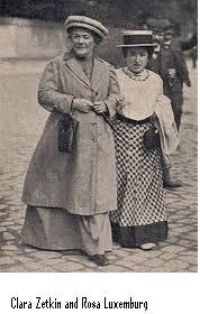
Alexandra Kollantai (1872-1953)
Alexandra Kollantai
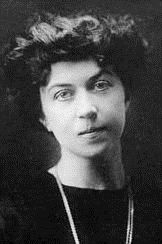
Kollantai in Sweden when she was a diplomat there
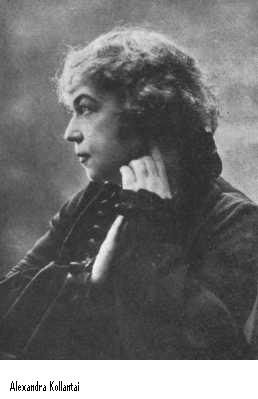
"Among the numerous problems raised by contemporary reality there is probably none more important for mankind, none more vital and urgent than the problem of motherhood created by the large-scale capitalist economic system. The problem of protecting and providing for the mother and young child is one that faces social politicians, knocks relentlessly at the door of the statesman, engages the health and hygiene specialists, concerns the social statistician, haunts the representative of the working class and weighs down on the shoulders of tens of millions of mothers compelled to earn their own living. Side by side with the problem of sex and marriage, enveloped in the poetical language of the psychological suffering, insoluble difficulties and unsatisfied needs of noble souls, there is always to be found the majestic and tragic figure of motherhood wearily carrying her heavy burden. Neo-malthusians, social-reformers and philanthropists have all hastened to provide their own particular solution to this thorny problem, and all sing the praises of their own method of restoring paradise lost to mothers and babies. The prosperity of national industry and the development of the national economy depend upon a constant supply of fresh labour… the principle of state maternity insurance [is] a principle in sharp contradiction with the present social structure as [it] undermines the basis of marriage and violates the fundamental concepts of private-family rights and relationships. However, if, in the name of 'higher' considerations of state and under the pressure of necessity, the state authorities have been compelled to advance and implement a measure so at odds with the prevailing spirit of the representatives of the bourgeois world, at the other end of the social scale, among the working class, the principle of providing for and protecting mother and child is welcomed with enthusiasm and sympathy. The demand that the social collective (the community) provide maternity insurance and child protection was born of the immediate and vital needs of the class of hired workers. Of all the strata of society, this class is the one which most requires that a solution be found to the painful conflict between compulsory professional labour by women and their duties as representatives of their sex, as mothers. Following a powerful class instinct rather than a clearly understood idea, the working class strove to find a way of resolving this conflict (Society and Motherhood 1915).
An ardent supporter of working class women, Kollantai, herself came from the bourgeois intelligentsia. Her father was a general and her mother came from a wealthy peasant family. Her mother's divorce from her first husband and the long and unhappy struggle of her parents to be together helped develop her ideas on love, sex and marriage which became a critical part of her feminist theory. Her own early marriage ended because she felt "trapped." She became increasingly involved with the populist ideas of the Peasant Commune in the 1890s which led her to the budding Marxist movement in Saint Petersburg. In 1898 she left her child by her first marriage with her parents and went to study economics abroad in Europe. In 1899, she returned to Russia where she met Lenin who supported her feminist ideas. She was a witness of the popular uprising in 1905 known as Bloody Sunday, at Saint Petersburg in front of the Winter Palace. She went into exile to Germany in 1908. She left Germany when the SPD supported WWI which she adamantly opposed. She settled in Norway where her antiwar views were accepted. She finally returned to Russia after the Tsar abdicated in 1917. She became the most well-known advocate for women's equality in Russia and the most prominent woman in the Soviet administration .She was best known for founding the Zhenotdel or "Women's Department" (1919) where she worked to improve the conditions of women's lives, fighting illiteracy and educating women about the new marriage, education, and working laws put in place by the Soviet Union (Alexandra Kollantai). In the 1920s, she joined a left-wing faction of the Communist party (Workers Opposition) that opposed Lenin and was effectively purged from any further meaningful role in the party. Because of her previously close relationship with Lenin, however, she was allowed to live out her days in various diplomatic positions abroad (Alexandra Kollantai ). Kollontai raised eyebrows with her unflinching advocacy of free love. Kollontai's views on the role of marriage and the family under Communism were arguably more influential on today's society than her advocacy of "free love." Kollontai believed that, like the state, the family unit would wither away. She viewed marriage and traditional families as legacies of the oppressive, property-rights-based, egoist past. Under Communism, both men and women would work for, and be supported by, society, not their families. Similarly, their children would be wards of, and reared basically by society. Kollontai admonished men and women to discard their nostalgia for traditional family life. "The worker-mother must learn not to differentiate between yours and mine; she must remember that there are only our children, the children of Russia’s communist workers." However, she also praised maternal attachment: "Communist society will take upon itself all the duties involved in the education of the child, but the joys of parenthood will not be taken away from those who are capable of appreciating them (Alexandra Kollantai)."
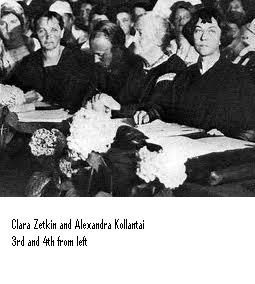


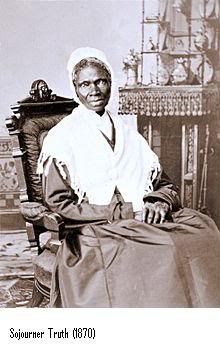
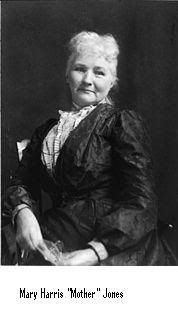

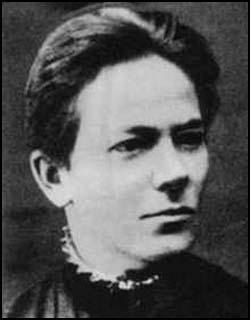


Comments
Thank you!
I very much appreciated this post, which offered so much detail about women who contributed to the Labor movement and to anti-Capitalism movements in so many countries. I appreciated learning about the early distinctions between 'upper-class'vs 'working class' versions of 'women's rights' which made even the Suffragists' efforts into a 'privileged position' as opposed to the more fundamental working class economic struggle.